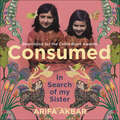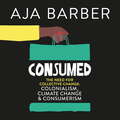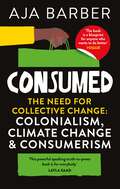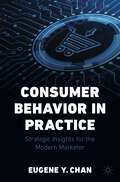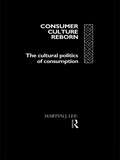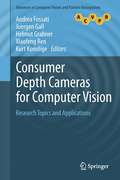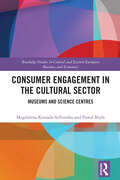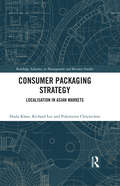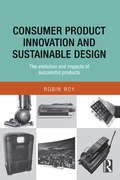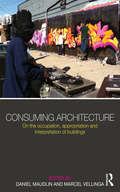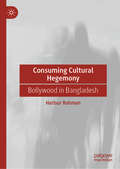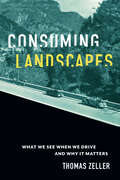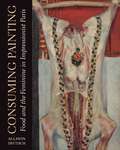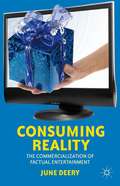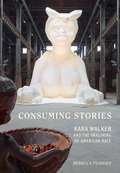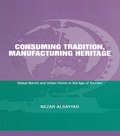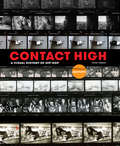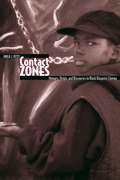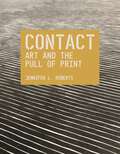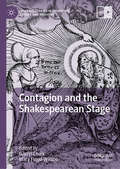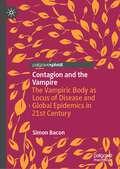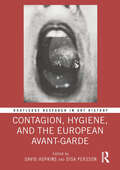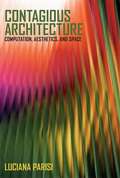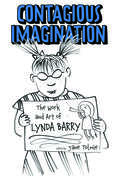- Table View
- List View
Consumed: A Sister’s Story - SHORTLISTED FOR THE COSTA BIOGRAPHY AWARD 2021
by Arifa AkbarA moving memoir about TB, grief, sisterhood, poverty and the reservoir of blame, guilt and unreliable memories from a troubled childhood in Lahore and London.All happy families are alike; each unhappy family is unhappy in its own way.When Arifa Akbar discovered that her sister had fallen seriously ill, she assumed there would be a brief spell in hospital and then she'd be home. This was not to be. It was not until the day before she died that the family discovered she was suffering from tuberculosis. Consumed is a story of sisterhood, grief, the redemptive power of art and the strange mythologies that surround tuberculosis. It takes us from Keats's deathbed and the tubercular women of opera to the resurgence of TB in modern Britain today. Arifa travels to Rome to haunt the places Keats and her sister had explored, to her grandparent's house in Pakistan, to her sister's bedside at the Royal Free Hospital in Hampstead and back to a London of the seventies when her family first arrived, poor, homeless and hungry. Consumed is an eloquent and moving excavation of a family's secrets and a sister's detective story to understand her sibling.(P) 2021 Hodder & Stoughton Ltd
Consumed: The need for collective change; colonialism, climate change & consumerism
by Aja BarberAja Barber wants change. In the 'learning' first half of the book, she will expose you to the endemic injustices in our consumer industries and the uncomfortable history of the textile industry; one which brokered slavery, racism and today's wealth inequality. And how these oppressive systems have bled into the fashion industry and its lack of diversity and equality. She will also reveal how we spend our money and whose pockets it goes into and whose it doesn't (clue: the people who do the actual work) and will tell her story of how she came to learn the truth.In the second 'unlearning' half of the book, she will help you to understand the uncomfortable truth behind why you consume the way you do. She asks you to confront the sense of lack you have, the feeling that you are never quite enough and the reasons why you fill the aching void with consumption rather than compassion. And she makes you challenge this power disparity, and take back ownership of it. The less you buy into the consumer culture the more power you have.CONSUMED will teach you how to be a citizen not a consumer.(p) 2021 Octopus Publishing Group
Consumed: The need for collective change; colonialism, climate change & consumerism
by Aja Barber'Consumed takes us through the hideously complex topic of fashion and sustainability, from its knotty colonial roots to what everyday people can do to uproot those systems, today.' - Yassmin Abdel-Magied 'SUCH integrity. Aja is no bullsh*t.' - Florence Given Aja Barber wants change. In the 'learning' first half of the book, she will expose you to the endemic injustices in our consumer industries and the uncomfortable history of the textile industry; one which brokered slavery, racism and today's wealth inequality. And how these oppressive systems have bled into the fashion industry and its lack of diversity and equality. She will also reveal how we spend our money and whose pockets it goes into and whose it doesn't (clue: the people who do the actual work) and will tell her story of how she came to learn the truth.In the second 'unlearning' half of the book, she will help you to understand the uncomfortable truth behind why you consume the way you do. She asks you to confront the sense of lack you have, the feeling that you are never quite enough and the reasons why you fill the aching void with consumption rather than compassion. And she makes you challenge this power disparity, and take back ownership of it. The less you buy into the consumer culture the more power you have.CONSUMED will teach you how to be a citizen not a consumer. 'An absolute must-read for any person who wears clothes.' - Orsola de Castro 'A hugely compelling exploration of a culture of exploitation and how, together, we can end it.' - Gina Martin 'Barber's isn't just a voice we should listen to - it is a voice we MUST listen to.' - Clementine Ford 'If you buy one book about sustainable fashion, make it this one. Consumed is an urgent call to action to demand a fashion system that is actually fair for both people and planet, not just Big Fashion billionaires. I adore Aja and I love this brilliant book.' - Venetia La Manna
Consumer Behavior in Practice: Strategic Insights for the Modern Marketer
by Eugene Y. ChanAimed at marketing students and practitioners, this book places less emphasis on theory but, instead, helps readers to understand why their customers are acting in a certain way or why their marketing activities or initiatives are not (or are) working out.The text examines the relevance of consumer behavior in such marketing topics as advertising and pricing, with topical chapters such as the sharing economy, luxury consumer behavior, and the ideological consumer. Each chapter includes boxes that highlight theory in greater depth; show how the concepts discuss “work” in actual practice; and the relevance of digital and social media marketing.This book will prove useful to those looking for a greater understanding of how consumer behavior provides greater insight about marketing activities.
Consumer Culture Reborn: The Cultural Politics of Consumption
by Martyn J. LeeFirst published in 1993. Routledge is an imprint of Taylor & Francis, an informa company.
Consumer Depth Cameras for Computer Vision: Research Topics and Applications (Advances in Computer Vision and Pattern Recognition)
by Andrea Fossati Helmut Grabner Kurt Konolige Juergen Gall Xiaofeng RenThe potential of consumer depth cameras extends well beyond entertainment and gaming, to real-world commercial applications. This authoritative text reviews the scope and impact of this rapidly growing field, describing the most promising Kinect-based research activities, discussing significant current challenges, and showcasing exciting applications. Features: presents contributions from an international selection of preeminent authorities in their fields, from both academic and corporate research; addresses the classic problem of multi-view geometry of how to correlate images from different viewpoints to simultaneously estimate camera poses and world points; examines human pose estimation using video-rate depth images for gaming, motion capture, 3D human body scans, and hand pose recognition for sign language parsing; provides a review of approaches to various recognition problems, including category and instance learning of objects, and human activity recognition; with a Foreword by Dr. Jamie Shotton.
Consumer Engagement in the Cultural Sector: Museums and Science Centres (Routledge Studies in Central and Eastern European Business and Economics)
by Magdalena Kosiada-Sylburska Paweł BryłaThe essence of the book is to investigate the forms, benefits and limitations of engaging consumers in the development of cultural institution offerings. It aims to identify methods for culture product development with consumer engagement, in particular concerning exhibition and educational activities of cultural institutions. The volume provides an extensive literature review of issues related to market orientation, customer centricity, consumer engagement and co-creation of products and services, with an emphasis on the specificity of the cultural sector.The authors conduct research to capture different perspectives on consumer engagement, including those of consumers themselves, managers responsible for designing the offer and cultural institution employees. They identify forms, success factors of and barriers to involving consumers (visitors) in the development of museum offerings. The combination of quantitative and qualitative research methods provides novel and valuable insights into the phenomenon under study. This book will be of interest to scholars interested in culture marketing and consumer behaviour, as well as managers of museums, science centres and other cultural institutions.
Consumer Packaging Strategy: Localisation in Asian Markets (Routledge Advances in Management and Business Studies)
by Richard Lee Huda Khan Polymeros ChrysochouThe consumer packaged goods (CPG) industry is dominated by major Western brands. The dominance of such major brands extends to Asian burgeoning markets. These conglomerates often rely on packaging as a strategic tool to entice Asian consumers. This book illustrates how packaging as a marketing tool is more than simply changing the label or translating the brand into vernacular language. It examines how different packaging elements (e.g. information, imagery, packaging type) can help to communicate product values to Asian consumers. Drawing upon rich knowledge of the Asian CPG markets with extensive findings from fieldworks in the key Asian markets, this book explains how Western brands are localising their packaging design in Asian markets. It provides invaluable insight into how major Western CPG brands have relied heavily on their packaging strategies to compete not only against domestic brands but also against other foreign brands. The book includes in-depth interviews with brand managers of several major Western CPG brands and retailers, and sheds light on emerging trends of CPG packaging in Asia.
Consumer Product Innovation and Sustainable Design: The Evolution and Impacts of Successful Products
by Robin RoyConsumer Product Innovation and Sustainable Design follows the innovation and evolution of consumer products from vacuum cleaners to mobile phones from their original inventions to the present day. It discusses how environmental concerns and legislation have influenced their design and the profound effects these products have had on society and culture. This book also uses the lessons from the successes and failures of examples of these consumer products to draw out practical guidelines for designers, engineers, marketers and managers on how to become more effective at product development, innovation and designing for environmental sustainability.
Consuming Architecture: On the occupation, appropriation and interpretation of buildings
by Daniel Maudlin Marcel VellingaProjecting forward in time from the processes of design and construction that are so often the focus of architectural discourse, Consuming Architecture examines the variety of ways in which buildings are consumed after they have been produced, focusing in particular on processes of occupation, appropriation and interpretation. Drawing on contributions by architects, historians, anthropologists, literary critics, artists, film-makers, photographers and journalists, it shows how the consumption of architecture is a dynamic and creative act that involves the creation and negotiation of meanings and values by different stakeholders and that can be expressed in different voices. In so doing, it challenges ideas of what constitutes architecture, architectural discourse and architectural education, how we understand and think about it, and who can claim ownership of it. Consuming Architecture is aimed at students in architectural education and will also be of interest to students and researchers from disciplines that deal with architecture in terms of consumption and material culture.
Consuming Cultural Hegemony: Bollywood in Bangladesh
by Harisur RahmanThis book examines the circulation and viewership of Bollywood films and filmi modernity in Bangladesh. The writer poses a number of fundamental questions: what it means to be a Bangladeshi in South Asia, what it means to be a Bangladeshi fan of Hindi film, and how popular film reflects power relations in South Asia. The writer argues that partition has resulted in India holding hegemonic power over all of South Asia’s nation-states at the political, economic, and military levels–a situation that has made possible its cultural hegemony. The book draws on relevant literature from anthropology, sociology, film, media, communication, and cultural studies to explore the concepts of hegemony, circulation, viewership, cultural taste, and South Asian cultural history and politics.
Consuming Landscapes: What We See When We Drive and Why It Matters
by Thomas ZellerWhat we see through our windshields reflects ideas about our national identity, consumerism, and infrastructure.For better or worse, windshields have become a major frame for viewing the nonhuman world. The view from the road is one of the main ways in which we experience our environments. These vistas are the result of deliberate historical forces, and humans have shaped them as they simultaneously sought to be transformed by them. In Consuming Landscapes, Thomas Zeller explores how what we see while driving reflects how we view our societies and ourselves, the role that consumerism plays in our infrastructure, and ideas about reshaping the environment in the twentieth century.Zeller breaks new ground by comparing the driving experience and the history of landscaped roads in the United States and Germany, two major automotive countries. He focuses specifically on the Blue Ridge Parkway in the United States and the German Alpine Road as case studies. When the automobile was still young, an early twentieth-century group of designers—landscape architects, civil engineers, and planners—sought to build scenic infrastructures, or roads that would immerse drivers in the landscapes that they were traversing. As more Americans and Europeans owned cars and drove them, however, they became less interested in enchanted views; safety became more important than beauty. Clashes between designers and drivers resulted in different visions of landscapes made for automobiles. As strange as it may seem to twenty-first-century readers, many professionals in the early twentieth century envisioned cars and roads, if properly managed, as saviors of the environment. Consuming Landscapes illustrates how the meaning of infrastructures changed as a result of use and consumption. Such changes indicate a deep ambivalence toward the automobile and roads, prompting the question: can cars and roads bring us closer to nature while deeply altering it at the same time?
Consuming Painting: Food and the Feminine in Impressionist Paris
by Allison DeutschIn Consuming Painting, Allison Deutsch challenges the pervasive view that Impressionism was above all about visual experience. Focusing on the language of food and consumption as they were used by such prominent critics as Baudelaire and Zola, she writes new histories for familiar works by Manet, Monet, Caillebotte, and Pissarro and creates fresh possibilities for experiencing and interpreting them. Examining the culinary metaphors that the most influential critics used to express their attraction or disgust toward painting, Deutsch rethinks French modern-life painting in relation to the visceral reactions that these works evoked in their earliest publics. Writers posed viewing as analogous to ingestion and used comparisons to food to describe the appearance of paint and the painter’s process. The food metaphors they chose were aligned with specific female types, such as red meat for sexualized female flesh, confections for fashionably made-up women, and hearty vegetables for agricultural laborers. These culinary figures of speech, Deutsch argues, provide important insights into both the fabrication of the feminine and the construction of masculinity in nineteenth-century France. Consuming Painting exposes the social politics at stake in the deeply gendered metaphors of sense and sensation.Original and convincing, Consuming Painting upends traditional narratives of the sensory reception of modern painting. This trailblazing book is essential reading for specialists in nineteenth-century art and criticism, gender studies, and modernism.
Consuming Painting: Food and the Feminine in Impressionist Paris
by Allison DeutschIn Consuming Painting, Allison Deutsch challenges the pervasive view that Impressionism was above all about visual experience. Focusing on the language of food and consumption as they were used by such prominent critics as Baudelaire and Zola, she writes new histories for familiar works by Manet, Monet, Caillebotte, and Pissarro and creates fresh possibilities for experiencing and interpreting them. Examining the culinary metaphors that the most influential critics used to express their attraction or disgust toward painting, Deutsch rethinks French modern-life painting in relation to the visceral reactions that these works evoked in their earliest publics. Writers posed viewing as analogous to ingestion and used comparisons to food to describe the appearance of paint and the painter’s process. The food metaphors they chose were aligned with specific female types, such as red meat for sexualized female flesh, confections for fashionably made-up women, and hearty vegetables for agricultural laborers. These culinary figures of speech, Deutsch argues, provide important insights into both the fabrication of the feminine and the construction of masculinity in nineteenth-century France. Consuming Painting exposes the social politics at stake in the deeply gendered metaphors of sense and sensation.Original and convincing, Consuming Painting upends traditional narratives of the sensory reception of modern painting. This trailblazing book is essential reading for specialists in nineteenth-century art and criticism, gender studies, and modernism.
Consuming Reality
by June DeeryEngaging in a comprehensive examination of reality TV's advertising and promotional strategies, as well as the commodification of viewers, Consuming Reality dissects the unique and startling relation between mediation and consumption.
Consuming Stories: Kara Walker and the Imagining of American Race
by Rebecca PeabodyIn Consuming Stories, Rebecca Peabody uses the work of contemporary American artist Kara Walker to investigate a range of popular storytelling traditions with roots in the nineteenth century and ramifications in the present. Focusing on a few key pieces that range from a wall-size installation to a reworked photocopy in an artist's book and from a theater curtain to a monumental sculpture, Peabody explores a significant yet neglected aspect of Walker's production: her commitment to examining narrative depictions of race, gender, power, and desire.
Consuming Tradition, Manufacturing Heritage: Global Norms and Urban Forms in the Age of Tourism
by Nezar AlSayyadFrom the Grand Tour to today's packages holidays, the last two centuries have witnessed an exponential growth in travel and tourism and, as the twenty-first century unfolds, people of every class and from every country will be wandering to every part of the planet.Meanwhile tourist destinations throughout the world find themselves in ever more fierce competition - those places marginalized in today's global industrial and information economy perceiving tourism as perhaps the only means of surviving. But mass tourism has raised the local and international passions as people decry the irreversible destruction of traditional places and historic sites.Against these trends and at a time when standardized products and services are marketed worldwide, there is an increasing demand for built environments that promise unique cultural experiences. This has led many nations and groups to engage in the parallel processes of facilitating the consumption of tradition and of manufacturing tradition.The contributors to this volume - drawn from a wide range of disciplines - address these themes within the following sections: Traditions and Tourism: Rethinking the "Other"; Imaging and Manufacturing Heritage; Manufacturing and Consuming: Global and Local. Their studies, dealing with very different times, environments and geographic locales, will shed new light on how tourist 'gaze' transforms the reality of built spaces into cultural imagery.
Contact High: A Visual History of Hip-Hop
by Questlove Vikki TobakAn inside look at the work of hip-hop photographers told through their most intimate diaries—their contact sheets. Featuring rare outtakes from over 100 photoshoots alongside interviews and essays from industry legends, Contact High: A Visual History of Hip-Hop takes readers on a chronological journey from old-school to alternative hip-hop and from analog to digital photography. The ultimate companion for music and photography enthusiasts, Contact High is the definitive history of hip-hop’s early days, celebrating the artists that shaped the iconic album covers, t-shirts and posters beloved by hip-hop fans today. With essays from BILL ADLER, RHEA L. COMBS, FAB 5 FREDDY, MICHAEL GONZALES, YOUNG GURU, DJ PREMIER, and RZA
Contact Zones: Memory, Origin, and Discourses in Black Diasporic Cinema
by Sheila J. PettyCreated at the crossroads of slavery, migration, and exile, and comprising a global population, the black diaspora is a diverse space of varied histories, experiences, and goals. Likewise, black diasporic film tends to focus on the complexities of transnational identity, which oscillates between similarity and difference and resists easy categorization. In Contact Zones author Sheila J. Petty addresses a range of filmmakers, theorists, and issues in black diasporic cinema, highlighting their ongoing influences on contemporary artistic and theoretical discourses. Petty examines both Anglophone and Francophone films and theorists, divided according to this volume's three thematic sections--Slavery, Migration and Exile, and Beyond Borders. The feature films and documentaries considered--which include Sankofa, Daughters of the Dust, The Man by the Shore, and Rude, among others--represent a wide range of cultures and topics. Through close textual analysis that incorporates the work of well-known diasporic thinkers like W. E. B. DuBois, Aimé Césaire, and Frantz Fanon along with contemporary notables such as Molefi Kete Asante, bell hooks, Clenora Hudson-Weems, René Depestre, Paul Gilroy, and Rinaldo Walcott, Petty details the unique ways in which black diasporic films create meaning. By exploring a variety of African American, Caribbean, Black British, and African Canadian perspectives, Contact Zones provides a detailed survey of the diversity and vitality of black diasporic contributions to cinema and theory. This volume will be a welcome addition to the libraries of scholars and students of film studies and Africana studies.
Contact: Art and the Pull of Print (The A. W. Mellon Lectures in the Fine Arts #70)
by Jennifer L. RobertsA leading art historian presents a new grammar for understanding the meaning and significance of printIn process and technique, printmaking is an art of physical contact. From woodcut and engraving to lithography and screenprinting, every print is the record of a contact event: the transfer of an image between surfaces, under pressure, followed by release. Contact reveals how the physical properties of print have their own poetics and politics and provides a new framework for understanding the intelligence and continuing relevance of printmaking today.The seemingly simple physics of printmaking brings with it an array of metamorphoses that give expression to many of the social and conceptual concerns at the heart of modern and contemporary art. Exploring transformations such as reversal, separation, and interference, Jennifer Roberts explores these dynamics in the work of Christiane Baumgartner, David Hammons, Edgar Heap of Birds, Jasper Johns, Corita Kent, Glenn Ligon, Julie Mehretu, Robert Rauschenberg, and many other leading artists who work at the edge of the medium and beyond.Focusing on the material and spatial transformations of the printmaking process rather than its reproducibility, this beautifully illustrated book explores the connections between print, painting, and sculpture, but also between the fine arts, industrial arts, decorative arts, and domestic arts. Throughout, Roberts asks what artists are learning from print, and what we, in turn, can learn from them.Published in association with the Center for Advanced Study in the Visual Arts, National Gallery of Art, Washington
Contagion and the Shakespearean Stage (Palgrave Studies in Literature, Science and Medicine)
by Mary Floyd-Wilson Darryl ChalkThis collection of essays considers what constituted contagion in the minds of early moderns in the absence of modern germ theory. In a wide range of essays focused on early modern drama and the culture of theater, contributors explore how ideas of contagion not only inform representations of the senses (such as smell and touch) and emotions (such as disgust, pity, and shame) but also shape how people understood belief, narrative, and political agency. Epidemic thinking was not limited to medical inquiry or the narrow study of a particular disease. Shakespeare, Thomas Middleton, Ben Jonson, Thomas Dekker and other early modern writers understood that someone might be infected or transformed by the presence of others, through various kinds of exchange, or if exposed to certain ideas, practices, or environmental conditions. The discourse and concept of contagion provides a lens for understanding early modern theatrical performance, dramatic plots, and theater-going itself.
Contagion and the Vampire: The Vampiric Body as Locus of Disease and Global Epidemics in 21st Century
by Simon BaconThis book examines how the vampire has always been connected to ideas of infection, pollution and disease—even more so in the 21st century where it expresses the horrors of unseen and unstoppable disease and the foreboding and anxiety that accompany viral outbreaks and wider epidemics. Here the vampire gives physical form to the contagion and associated anxieties around the perceived causes and spread of disease, where it can take on many forms from animal to pestilential particulate matter, creeping shadows and even malignant weather systems. If blood is life, it is the body of the vampire that is death. This timely study looks at how and why the vampire continues to fulfil this function and posits that the true patient zero in the 21st century is no longer the dangerous, ancient, outsider from the East but is the undying monster that is Western culture itself.
Contagion, Hygiene, and the European Avant-Garde (Routledge Research in Art History)
by David Hopkins Disa PerssonThis interdisciplinary collection of essays brings together scholars in the fields of art history, theatre, visual culture, and literature to explore intersections between the European avant-garde (c. 1880–1945) and themes of health and hygiene, such as illness, contagion, cleanliness, and contamination. Examining the artistic oeuvres of some of the canonical names of modern art – including Edgar Degas, Edvard Munch, Pablo Picasso, George Orwell, Marcel Duchamp, and Antonin Artaud – this book investigates instances where the heightened political, social, and cultural currencies embedded within issues of hygiene and contagion have been mobilised, and subversively exploited, to fuel the critical strategy at play. This edited volume promotes an interdisciplinary and socio-historically contextualised understanding of the criticality of the avant-garde gesture and cultivates scholarship that moves beyond the limits of traditional academic subjects to produce innovative and thought-provoking connections and interrelations across various fields. The book will be of interest to scholars working in art history, literature, theatre, cultural studies, modern history, medical humanities, and visual culture.
Contagious Architecture: Computation, Aesthetics and Space
by Luciana ParisiIn Contagious Architecture, Luciana Parisi offers a philosophical inquiry into the status of the algorithm in architectural and interaction design. Her thesis is that algorithmic computation is not simply an abstract mathematical tool but constitutes a mode of thought in its own right, in that its operation extends into forms of abstraction that lie beyond direct human cognition and control. These include modes of infinity, contingency, and indeterminacy,as well as incomputable quantities underlying the iterative process of algorithmic processing. The main philosophical source for the project is Alfred North Whitehead, whose process philosophy is specifically designed to provide a vocabulary for "modes of thought"exhibiting various degrees of autonomy from human agency even as they are mobilized by it. Because algorithmic processing lies at the heart of the design practices now reshaping our world -- from the physical spaces of our built environment to the networked spaces of digital culture -- the nature of algorithmic thought is a topic of pressing importance that reraises questions of control and,ultimately, power. Contagious Architecture revisits cybernetic theories of control and information theory's notion of the incomputable in light of this rethinking of the role of algorithmic thought. Informed by recent debates in political and cultural theory around the changing landscape of power, it links the nature of abstraction to a new theory of power adequate to the complexities of the digital world.
Contagious Imagination: The Work and Art of Lynda Barry (Critical Approaches to Comics Artists Series)
by Glenn WillmottContributions by Frederick Luis Aldama, Melissa Burgess, Susan Kirtley, Rachel Luria, Ursula Murray Husted, Mark O’Connor, Allan Pero, Davida Pines, Tara Prescott-Johnson, Jane Tolmie, Rachel Trousdale, Elaine Claire Villacorta, and Glenn WillmottLynda Barry (b. 1956) is best known for her distinctive style and unique voice, first popularized in her underground weekly comic Ernie Pook’s Comeek. Since then, she has published prolifically, including numerous comics, illustrated novels, and nonfiction books exploring the creative process. Barry’s work is genre- and form-bending, often using collage to create what she calls “word with drawing” vignettes. Her art, imaginative and self-reflective, allows her to discuss gender, race, relationships, memory, and her personal, everyday lived experience. It is through this experience that Barry examines the creative process and offers to readers ways to record and examine their own lives. The essays in Contagious Imagination: The Work and Art of Lynda Barry, edited by Jane Tolmie, study the pedagogy of Barry’s work and its application academically and practically. Examining Barry’s career and work from the point of view of research-creation, Contagious Imagination applies Barry’s unique mixture of teaching, art, learning, and creativity to the very form of the volume, exploring Barry’s imaginative praxis and offering readers their own. With a foreword by Frederick Luis Aldama and an afterword by Glenn Willmott, this volume explores the impact of Barry’s work in and out of the classroom. Divided into four sections—Teaching and Learning, which focuses on critical pedagogy; Comics and Autobiography, which targets various practices of rememorying; Cruddy, a self-explanatory category that offers two extraordinary critical interventions into Barry criticism around a challenging text; and Research-Creation, which offers two creative, synthetic artistic pieces that embody and enact Barry’s own mixed academic and creative investments—this book offers numerous inroads into Barry’s idiosyncratic imagination and what it can teach us about ourselves.
